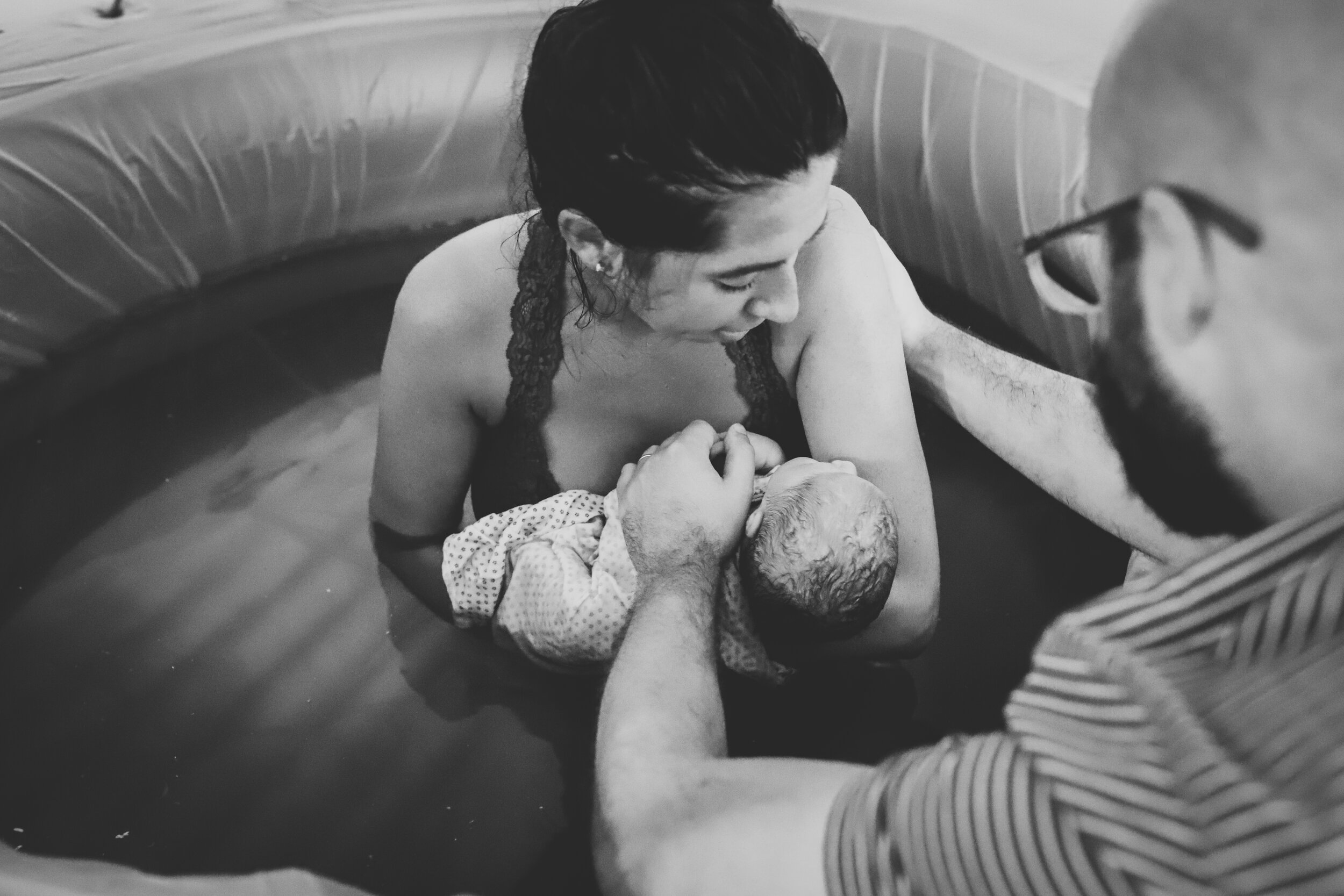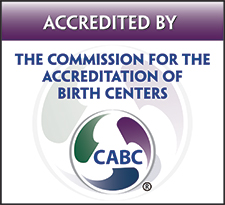Many people find relief from the aches and pains of pregnancy in water. Soaking in warm water can help relax the muscles; improve circulation; decrease sensitivity to pain; provide buoyancy to ease heavy-feeling bellies, legs, or backs; and allow movement that may be more challenging on land. A tub also creates a physical barrier that can provide a sense of safety and privacy. Because the bath is a familiar and comforting place for many people during their pregnancies, it’s also a great tool to use during labor and birth. Our statistics over the past few years show that about 25-30% of our clients have waterbirths, and the majority of our clients spend time laboring in water.
Waterbirth has become increasingly popular since the 1980s, but before we dive in, we need to define a few terms. Water immersion in labor is when a person uses a tub or pool of warm water during early or active labor, but before the baby is born. Waterbirth is when the birthing person stays in the tub during the pushing stage and actual birth. After the birth, the baby is brought to the surface by the midwife, partner, or the birthing person themself. This is followed by the birth of the placenta, either in or out of the water. In contrast, a land birth refers to the birth of a baby on dry land (outside the tub).
A Cochrane Review found that immersion in water during labor and birth reduces the use of epidurals and spinals for pain relief and shortens the length of first stage labor by an average of 32 minutes. There is no evidence of harm to birthing people or their babies from laboring in water. Additional research has shown that there are no differences in neonatal mortality, NICU rates, APGAR scores, or infection rates between babies born on land and those born in water. The proven benefits of waterbirth include less pain, less use of medications for pain relief, less use of artificial oxytocin, shorter labors, a higher rate of normal vaginal birth, a higher rate of intact perineum, less use of episiotomy, and greater satisfaction with the birth. Potential benefits include lower rates of severe tears (3rd or 4th degree) and lower rates of postpartum hemorrhage. Evidence Based Birth has an excellent article summarizing current research on water immersion in labor and waterbirth.
The American College of Nurse Midwives, American Association of Birth Centers, and the Royal College of Obstetricians in the U.K. all support waterbirth as an appropriate option for low-risk birthing people. On the other hand, the American Congress of Obstetricians and Gynecologists came out with an Opinion Statement in 2014 that was strongly against waterbirth. They have since revised their statement to acknowledge that potential risks have not been sufficiently studied and that there are many benefits to immersion in water during labor for birthing people, but continue to recommend birth on land.
Despite the safety and myriad benefits of water birth, there are few local facilities that provide this option, and all are outside of the hospital. In Western New York, most Labor and Delivery hospital rooms have tubs, but these are strictly used during labor, and pregnant people must get out (or have the tub drained) when it’s time to give birth. At Fika Midwifery, we support you wherever you want to have your baby. Each room at The Coit House has its own birth tub, and we have an unlimited supply of hot water. Our home birth clients can rent birth tubs from us and pick them up at their 36 week visit, along with all of the other supplies they need.
While you’re in the tub, remember to stay hydrated. You can also keep your head or neck cool with cold compresses. For some people, immersion in water can make their contractions space out or stall. Usually this is okay and can actually be beneficial! It’s your body’s way of giving you a break and allowing you to rest up for when your labor becomes more active. In early labor, the goal of positioning and comfort measures is allowing yourself to rest. There is almost always a point in labor where nothing you do will stop your contractions.
Once you’re in active labor, the goal shifts to moving and switching positions and comfort measures to help your baby descend and rotate into the optimal position. As the adage goes, change brings change. This means that during active labor your midwife, doula, or other support person might encourage you to get out of the tub if you’ve been in for awhile or to get into the tub if you’ve been laboring on land.
Trust your intuition. During my own labor, I instinctually created a little circuit for myself. Every few contractions I would move from side lying on my couch, stopping for a break hunched over my dining room table, before getting in the tub. Then back to the table, and eventually back to the couch. When it was time to push, I truly felt like I could not be anywhere other than in the birth pool and declined my midwife’s suggestion of the stool. I ended up having an incredibly gentle waterbirth. For many other people, even those who planned a waterbirth, it’s the opposite, and they know they need to birth on land. You know what you need better than anyone else.
The most important thing about your birth is that you feel safe and supported in whatever decisions you make for your body and your baby, whether that’s in water or on land!
Author Mary Badame is the Quality Assurance Manager at Fika Midwifery and is a passionate advocate for midwife-led care, increased birth options, and better reproductive healthcare for everyone.




